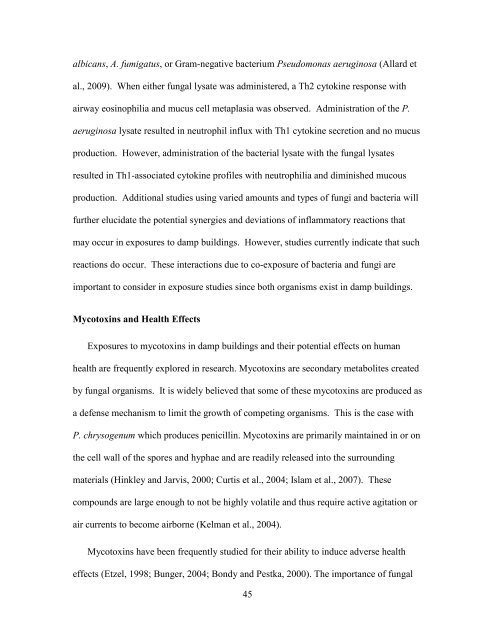INDUCTION OF DEPRESSION BY EXPOSURE TO DAMP ...
INDUCTION OF DEPRESSION BY EXPOSURE TO DAMP ...
INDUCTION OF DEPRESSION BY EXPOSURE TO DAMP ...
Create successful ePaper yourself
Turn your PDF publications into a flip-book with our unique Google optimized e-Paper software.
albicans, A. fumigatus, or Gram-negative bacterium Pseudomonas aeruginosa (Allard et<br />
al., 2009). When either fungal lysate was administered, a Th2 cytokine response with<br />
airway eosinophilia and mucus cell metaplasia was observed. Administration of the P.<br />
aeruginosa lysate resulted in neutrophil influx with Th1 cytokine secretion and no mucus<br />
production. However, administration of the bacterial lysate with the fungal lysates<br />
resulted in Th1-associated cytokine profiles with neutrophilia and diminished mucous<br />
production. Additional studies using varied amounts and types of fungi and bacteria will<br />
further elucidate the potential synergies and deviations of inflammatory reactions that<br />
may occur in exposures to damp buildings. However, studies currently indicate that such<br />
reactions do occur. These interactions due to co-exposure of bacteria and fungi are<br />
important to consider in exposure studies since both organisms exist in damp buildings.<br />
Mycotoxins and Health Effects<br />
Exposures to mycotoxins in damp buildings and their potential effects on human<br />
health are frequently explored in research. Mycotoxins are secondary metabolites created<br />
by fungal organisms. It is widely believed that some of these mycotoxins are produced as<br />
a defense mechanism to limit the growth of competing organisms. This is the case with<br />
P. chrysogenum which produces penicillin. Mycotoxins are primarily maintained in or on<br />
the cell wall of the spores and hyphae and are readily released into the surrounding<br />
materials (Hinkley and Jarvis, 2000; Curtis et al., 2004; Islam et al., 2007). These<br />
compounds are large enough to not be highly volatile and thus require active agitation or<br />
air currents to become airborne (Kelman et al., 2004).<br />
Mycotoxins have been frequently studied for their ability to induce adverse health<br />
effects (Etzel, 1998; Bunger, 2004; Bondy and Pestka, 2000). The importance of fungal<br />
45


